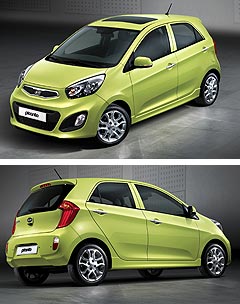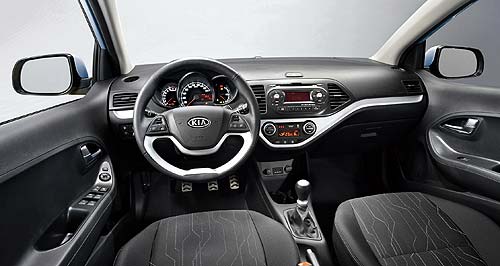Future models - Kia - PicantoNew Picanto details emergeOn the road: First image of the highly anticipated Kia Picanto on the road. Kia reveals engine line-up for new city car and continues to push for local debut24 Jan 2011 KIA has released engine details and more photos of its next-generation Picanto city car, which could make it to Australia within a year. With similar-size cars such as the Holden Barina Spark, Suzuki Alto and Nissan Micra making an impact on the local market, Kia Motors Australia is keen to bring the German-styled ‘A-segment’ hatchback here. Offered for the first time with a choice of five-door and three-door bodystyles, it will be presented for the first time in public at the Geneva motor show on March 1 (alongside the new Rio light car) before going on sale globally later this year. Kia Motors will initially offer four new engines globally, all from the ‘Kappa’ family of engines it will share with parent company Hyundai. As well as a trio of 1.0-litre three-cylinder engines ranging in power from 51kW to 63kW, Picanto will also get a 1.2-litre four-cylinder engine that is already fitted to the Hyundai i10 city car that is also under consideration for Australia. However, while the i10 is built in India, a KMAu spokesman said that, should the Picanto make it to Australia, it would be built in Korea. The engines will be mated to either five-speed gearboxes or four-speed autos. Of the three-cylinder engines, one runs on petrol, one flex fuel (ethanol-compatible) and one bi-fuel (petrol and LPG) – the latter being rated at 60kW, with 94Nm of torque. Kia boasts that the second-generation Picanto produces greatly reduced CO2 emissions (between 95 and 105 grams per kilometre) and improved fuel economy (ranging from 4.2 to 5.9L/100km). European models will be fitted with ISG (Idle Stop and Go) technology to cut emissions by a further 5g/km, qualifying all models for the tax savings in many Continental countries for cars emitting less than 100g/km while at the same time dropping consumption to between 4.1 and 5.6L/100km. By comparison, the Nissan Micra 1.2-litre manual in Australia produces 56kW and 100Nm, emits 138g/km and uses 5.9L/100km on the official ADR 81/02 regime, running on 91 octane unleaded petrol.  On the same basis, the Australian-market Holden Barina Spark is rated at 59kW/107Nm, 128g/km and 5.6L/100km while the 1.0-litre Suzuki Alto – running on 95-octane premium unleaded – records 50kW/90Nm, 110g/km and 4.8L/100km. On the same basis, the Australian-market Holden Barina Spark is rated at 59kW/107Nm, 128g/km and 5.6L/100km while the 1.0-litre Suzuki Alto – running on 95-octane premium unleaded – records 50kW/90Nm, 110g/km and 4.8L/100km.All three cars rate five stars in the federal government’s Green Vehicle Guide. Kia is understood to have a 1.1-litre CRDi diesel engine to introduce soon after launch, especially for European markets. KMAu public relations manager Kevin Hepworth said the company was still interested in bringing Picanto to Australia and was putting together a business plan to present to head office. “We definitely have an interest in the vehicle,” he said. “We’ve looked at it and we’re still looking at it. “Having seen it now – I drove it a couple of months ago – I’d have to say it’s very nice for a city-style car.” Kia is keeping most of the technical details under wraps until the opening of the Geneva show, but claims that cargo space has been increased by 27 per cent over the previous model, which is not surprising considering it is longer overall and sits on an extended wheelbase. The Picanto shares its underpinnings with the new Rio, which will also debut at Geneva before going on sale in Australia in the middle of this year. In a statement issued this week, Kia Motors said the new Picanto would maintain Kia’s reputation for delivering great value, and was “destined to be a highly competitive newcomer in the A-segment”. “New Picanto has been redesigned and re-engineered with stand-out styling that conveys a sense of solidity and maturity. “As well as offering new levels of powertrain efficiency, it boasts a distinctive exterior, sophisticated interior, and numerous ‘large car’ advanced comfort and safety features like LED daytime running lights, button-start with smart key, grip-type outside door handles and six or seven airbags, depending on region.” The car was designed in Germany by Kia’s styling team under the direction of Peter Schreyer, who has overseen a bold style revolution for the Korean company with a stronger family identity across the model range. The first photo of the interior, issued this week along with the first action shot, typically shows a high-spec model fitted with automatic climate control, steering wheel controls, power windows and mirrors, trip computer and multi-media functions. However, it also reveals a uniformity in style with the new-look exterior and an overall look that eschews Kia’s previous cheap and cheerful positioning. Lower sections of both the steering wheel and the dash are underscored by matt silver highlights that reflect the style of the car’s grille.  Read more5th of January 2011  First pictures: Kia hatches new babyPicanto city car revealed by Kia ahead of Geneva show debutAll future models Alfa Romeo Alfa Romeo Abarth Abarth Audi Audi Aston Martin Aston Martin BMW BMW Bentley Bentley Chrysler Chrysler Chevrolet Chevrolet Dodge Dodge Citroen Citroen Ferrari Ferrari DS DS Ford Ford Fiat Fiat FPV FPV Foton Foton Haval Haval Great Wall Great Wall Honda Honda Holden Holden Hyundai Hyundai HSV HSV Isuzu Isuzu Infiniti Infiniti Jeep Jeep Jaguar Jaguar Lamborghini Lamborghini Kia Kia Lexus Lexus Land Rover Land Rover Mazda Mazda Maserati Maserati Mercedes-Benz Mercedes-Benz McLaren McLaren Mini Mini Nissan Nissan Mitsubishi Mitsubishi Peugeot Peugeot Opel Opel Proton Proton Porsche Porsche Renault Renault Ram Ram Saab Saab Rolls-Royce Rolls-Royce Smart Smart Skoda Skoda Subaru Subaru SsangYong SsangYong Tesla Tesla Suzuki Suzuki Toyota Toyota Volvo VolvoPicanto pricingMotor industry news |
Click to shareKia modelsResearch Kia All future models Alfa Romeo Alfa Romeo Abarth Abarth Audi Audi Aston Martin Aston Martin BMW BMW Bentley Bentley Chrysler Chrysler Chevrolet Chevrolet Dodge Dodge Citroen Citroen Ferrari Ferrari DS DS Ford Ford Fiat Fiat FPV FPV Foton Foton Haval Haval Great Wall Great Wall Honda Honda Holden Holden Hyundai Hyundai HSV HSV Isuzu Isuzu Infiniti Infiniti Jeep Jeep Jaguar Jaguar Lamborghini Lamborghini Kia Kia Lexus Lexus Land Rover Land Rover Mazda Mazda Maserati Maserati Mercedes-Benz Mercedes-Benz McLaren McLaren Mini Mini Nissan Nissan Mitsubishi Mitsubishi Peugeot Peugeot Opel Opel Proton Proton Porsche Porsche Renault Renault Ram Ram Saab Saab Rolls-Royce Rolls-Royce Smart Smart Skoda Skoda Subaru Subaru SsangYong SsangYong Tesla Tesla Suzuki Suzuki Toyota Toyota Volvo VolvoPicanto pricingMotor industry news |
















Facebook Twitter Instagram